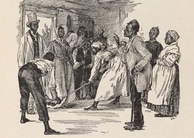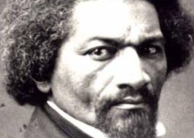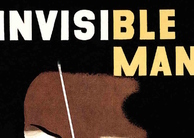John Temple Graves and the 'Lost Tribe:' An Analysis of "The Big World At Last Reaches Gee's Bend"
By
2012, Vol. 4 No. 08 | pg. 2/2 | « The idea that FSA projects could encourage African American embrace of their own way of life rather than stimulate a surge of ‘uppity Negros’ was reinforced by a series of photographs of the Gee’s Bend community by Farm Services Administration Historical Unit photographer Arthur Rothstein. The set was standard in terms of the bureau’s African American oeuvre – the depiction of a simplistic world apart was far less politically incendiary than urban photos of black poverty and there were many similar photographs in the Unit’s files. A picture of a man using an outdated plough system, of ramshackle cabins and small-town church education – representations of dedication and work ethic despite pauperism – affirmed the worthiness of Gee’s Benders to receive federal tax dollars to the general public. This justification of want established a new public perception of Southern rural poverty, reversing “a set of negative stereotypes…that had been entrenched within American culture…Only a slight shift of emphasis was required to transform rural deprivation into rustic charm” (Godden 2006, p.27). These photographs and the work of the Historical Unit, much like Graves’ backward-looking Progressivism, “contributed to the visualization of a tenant class as manageable Americana grounded in nineteenth-century values of pioneer individualism rather than the twentieth-century realities of economic oppression” (Ibid., p.xiii). Progress for the nation as a whole required African Americans to serve as martyrs and renounce progressivism for themselves. Graves’ assumptions to this degree were not controversial, at least to the Northern readership of the Times distracted by fiscal meltdown or those within his own Southern pseudo-liberal milieu. By and large, those who would object to his primitive characterization of African Americans or his separatism were those he sought to quiet rather than win over. His sentiments were echoed in other portrayals of Gee’s Bend in the media at the time, including Reverend Renwick Kennedy’s series of stories in Christian Century which dubbed the community an “Alabama Africa” (Smothers) in 1937.In fact, in most ways, the article mimicked promotional materials produced by the FSA itself throughout the 1930s and 1940s – the “before-and-after progress theme” (Natanson 1992, p.57) of resettlement projects permeated press releases and editorials and dictated much subject matter sought for the Historical Unit to gain support for the New Deal. Much like Graves’ article in the Times, these materials gave experimentalism a “folksy, populist tone” (Ibid., p.56), minimizing discussion of issues particular to African Americans, especially cultural ones, in favor of a class-based portrayal of need. “That the New Deal could put blacks to work while reaffirming deeply entrenched economic and cultural structures constituted an effective sales pitch” (Ibid., 36) both to Graves and his northern readership. The particular conditions of the town lent themselves to omission of the tensions, challenges, and concerns of blacks not only in the South, but across the American landscape in the 1930s. Graves could disregard Jim Crow and segregation because the entirety of Gee’s Bend was African American. He could ignore workplace discrimination and consumerism because the area was far removed from the urbanization and industrialism of the growing cities of the New South. He could fully embrace antebellum nostalgia without the stain of Confederate slavery. While Gee’s Benders were finally getting both feet on the ground in 1937, other black people across the South, particularly in urban areas, were not so lucky. It would be decades until a President would be forced to tackle the ‘Race Question’ and African American equality in the United States head on. While reaching out to the black farmer amidst racist conservative pressure was commendable, the specificities of Gee’s Bend reflect the extent to which the Roosevelt and future administrations were reluctant to reach out to all African Americans and facilitate uplift. ReferencesBanfield, E.C. (1949) ‘Ten Years of the Farm Tenant Purchase Program’. Journal of Farm Economics 31 (3), 469-486. Biles, R. (1994) The South and the New Deal. Lexington: The University Press of Kentucky. Egerton, J. (1994) Speak Now Against the Day: The Generation Before the Civil Rights Movement in the South. New York: Alfred A. Knopf. Encyclopedia of Alabama. (2011) Gee’s Bend [online] available from [April 2012]. Fishel, L.H. (1964-1965) ‘The Negro in the New Deal Era’. The Wisconsin Magazine of History 48 (2), 111-126. Foner, E. (2011) Give Me Liberty! An American History Vol. 2. New York: W.W. Norton & Company. Godden, R. and Crawford, M. (eds.) (2006) Reading Southern Poverty Between the Wars, 1918-1939. Athens: University of Georgia Press. Graves, J.T. (1937) The Big World At Last Reaches Gee’s Bend. New York Times, 22 Aug. Holley, D. (1971) ‘The Negro in the New Deal Resettlement Program’. Agricultural History 45 (3), 179-193. McGee, C. (2002) Alabama’s Quilts Patch Together a Story at Whitney. NY Daily News, [online] 20 Nov. available from [April 2012]. Natanson, N. (1992) The Black Image in the New Deal: The Politics of FSA Photography. Knoxville: The University of Tennessee Press. Smothers, B.J. (n.d.) Black Families of Alabama's Black Belt: History of Gee's Bend [online] available from [April 2012]. Trend, M.G. and Lett, W.L. (1986) ‘Government Capital and Minority Enterprise: An Evaluation of a Depression-Era Social Program’. American Anthropologist New Series 88 (3), 595-609. Wise, T. (2010) Colorblind: The Rise of Post-Racial Politics and the Retreat from Racial Equity. San Francisco: City Lights Books. Suggested Reading from Inquiries Journal
Inquiries Journal provides undergraduate and graduate students around the world a platform for the wide dissemination of academic work over a range of core disciplines. Representing the work of students from hundreds of institutions around the globe, Inquiries Journal's large database of academic articles is completely free. Learn more | Blog | Submit Latest in African-American Studies |


















